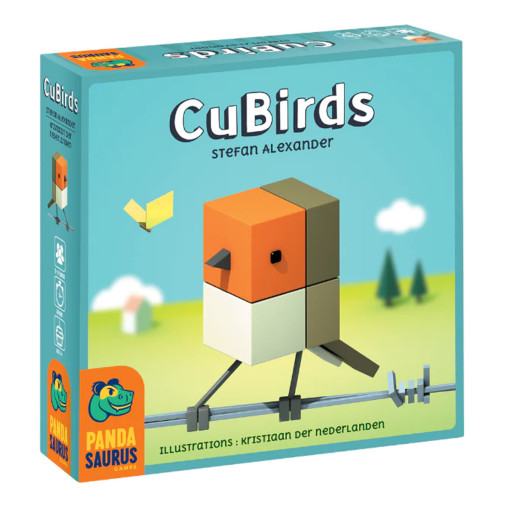We use cookies to make your experience better. To comply with the new e-Privacy directive, we need to ask for your consent to set the cookies. Learn more.
CuBirds Game
Help the birds find their flocks in this simple, quick 20-minute card game for 2-5 players. The goal in CuBirds is to be the first player to gather a collection of either 7 different bird species or 2 different species with three birds each to win the game!
To Start: Each player begins with a hand of eight cards and one starting bird in their collection. A display of birds consisting of four rows of three different birds is set up in the middle of the table and a draw pile of all remaining cards is created.
Game Play: On a turn, each player must place all cards of any species they have in their hand either at the beginning or end of any row in the display. There are two possible outcomes to that placement.
1. If a player’s card(s) matches another card in that row and there are different species between them, they collect all cards between the matching birds and slide the remaining cards together. If the remaining birds in that row are all the same species, they add cards from the deck until there are at least two species in that row.
2. If the placed card species does not match any others in that row or the placed card only matches the one immediately next to the card they just played and there are no different species between them, the player draws two cards from the deck instead.
Completing a Flock: Each species of birds has two numbers in the upper right-hand corner. For example, it might be 6/9 or 2/3. The number on the left is the number of cards of the species needed to create a small flock. The second number is the number needed to create a large flock. If the player has enough cards in their hand to create a small flock, they may keep one of these cards to add to their collection, or two cards can be added if they have enough cards for a large flock. The remaining cards of that species are discarded. If any player ends their turn with no cards in their hand, the round is over, and all players discard any remaining cards in their hand. At this time, the player who placed their last card in the discard pile deals each player eight new cards and proceeds to also take the first turn of the next round.
Once any player completes a winning collection (three of two different species or seven different species, the game immediately ends, and they are declared the winner! Pick up this cute collection of quirky looking bird cards, gather up your family or friend group and let the good times fly! ~Marsha
Every day, dozens of birds perch on the fences of our countryside. When it is time to fly away, these birds jumble up, unable to organize themselves into flocks to fly home. Help them find their way back to their nest!
There are 4 rows of birds in the center of the table. On their turn, players must choose 1 type of bird to play from their hand into one of the rows. If that bird type already exists in the row, they take any bird cards in between the two. Once a player only has 1 type of bird in their hand, they can reveal to "complete a Flock" and add one or two to their collection depending on the number of cards revealed.
The game is won by the first player that manages to have gathered in their collection either 7 different species or 2 species of at least 3 birds!
| Product Format: | Other |
|---|---|
| Brand: | Pandasaurus Games |
| Grades: | 3-AD |
| EAN/UPC: | 850029278849 |
| Length in Inches: | 6.1875 |
| Width in Inches: | 6.1875 |
| Height in Inches: | 1.75 |
| Weight in Pounds: | 0.75 |

